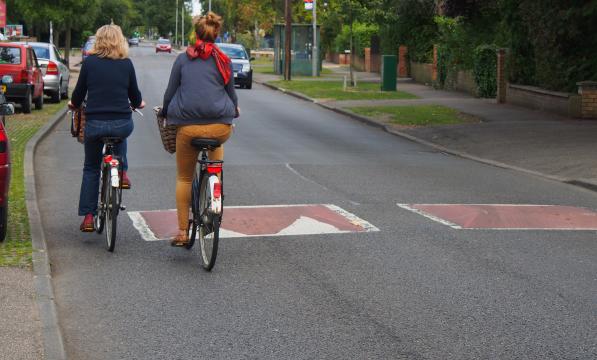Traffic calming

Headline message
- Traffic calming can benefit cyclists by reducing the speed of traffic, but it must be cycle-friendly.
Important!
Please note: in July 2020, the Department for Transport published new guidance on cycle infrastructure design (LTN1/20). We will be revising all our advice, policy and materials on infrastructure in the light of it as soon as possible. This exercise will include reviewing this page.
Please also note existing cycle infrastructure design guidance for London, Wales and Scotland (revision due). Plus, technical guidance for Local Cycling and Walking Infrastructure Plans (LCWIPs, England).
Policy key facts
- The aim of traffic calming is to slow down the average speed of motor vehicles. In doing so, it reduces the speed differential between them and other road users and helps make road conditions safer and more attractive for cycling.
- Traffic calming measures include physical alterations to the horizontal and vertical alignment of the road, e.g. speed humps and road narrowings such as chicanes.
- Traffic can be calmed in other, more subtle ways (e.g. by making the road look narrower than it actually is through surface design, planting etc).
- If done badly, though, physical traffic calming can push cyclists and motorists riskily together through pinch points (e.g. at built-out sections of kerb), or force cyclists to veer or struggle (e.g. round or over a speed hump that’s been put in an awkward place or doesn’t have enough clearance from the kerb). Good traffic calming should help people follow the guidance given by national standards cycle training, not do the opposite - riding in the gutter, for example.
- Traffic calming can be used as part of a package of other speed reducing measures, including 20 mph limits. Nowadays, however, local authorities have been given much more flexibility over introducing these limits without paying for costly physical infrastructure to enforce them.
Cycling UK view
We are currently revising and updating our detailed views on all aspects of cycling infrastructure and these will be published in due course. For general principles, please have a look at our 'overview' briefing on cycle-friendly design and planning.
The following is an extract from our Policy Handbook (March 2004):
- Traffic calming can benefit cyclists by reducing the speed of traffic, provided it is of a cycle-friendly design. Vertical deflection can be very effective at slowing traffic but the ramps must have long, smooth profiles, approximating to a sinusoidal shape.
- Wherever possible the introduction of pinch points that squeeze cyclists, e.g.: by providing central refuges, should be avoided. At 30 mph the minimum width beside a refuge that allows safe overtaking without intimidation is 4.5m. Only below 20 mph should narrower widths be considered.
- Pinch points should not be introduced without consultation with local cyclists.
2012-03-30 00:00:00 Europe/London


